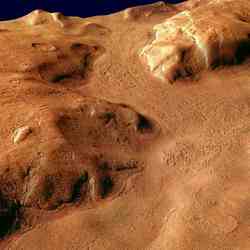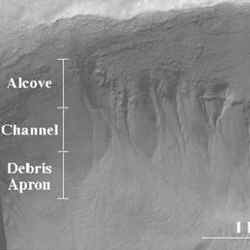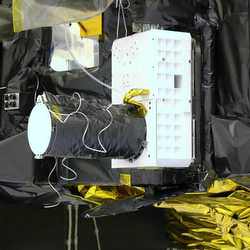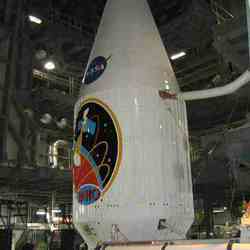
Perspective view of Reull Vallis. Image credit: ESA Click to enlarge
The Mars Reconnaissance Orbiter, set to launch on August 10, will search for evidence that liquid water once persisted on the surface of Mars. This orbiter also will provide detailed surveys of the planet, identifying any obstacles that could jeopardize the safety of future landers and rovers.
Jim Graf, Project Manager for the Mars Reconnaissance Orbiter, gave a talk where he provided an overview of the mission. In part one of this edited transcript, Graf discusses previous studies of Mars, and describes the steps that will put MRO in orbit around the Red Planet.
“In the 1900s, our knowledge of Mars was based on looking at albedo features, the bright and dark spots. And, guess what? They moved all over. We didn’t know about the dust storms that cover the planet, since all we could do was look at Mars through a telescope from afar. We also saw a lot of straight lines, and some people believed those lines were canals that brought water from the poles down to the arid regions. There were little green men running around in oases all over.
Fast-forward sixty-five years to when Mariner 4 came by, we saw a moon-like surface: craters, no real water, devoid of life, no Martians, no oases, no canals. At that particular point in time we said, ‘There’s nothing really there. Let’s go look elsewhere.’ But thankfully, future Mariners were in the queue and already had been approved for going to Mars to investigate it more thoroughly. When they arrived there, our image of Mars changed. We saw evidence that water once flowed on the surface. There were craters that had been partly subsumed, crater walls that were partly destroyed as if water flowed by. Other images showed almost delta-like regions, where water had been captured in one area and then came down in streams and gullies.
The wide angle view of the martian north polar cap was acquired on March 13, 1999, during early northern summer. The light-toned surfaces are residual water ice that remains through the summer season. The nearly circular band of dark material surrounding the cap consists mainly of sand dunes formed and shaped by wind. Credit: NASA/JPL/Malin Space Science Systems
We’ve had a lot of orbiters since the Mariner missions, and not only do we see water features in the land, but we also see evidence of tectonics, or possibly volcanic activity. Olympus Mons is the largest volcano in the solar system. Valles Marineris, named after the Mariner spacecraft that found it, is 4,000 kilometers wide, the same distance across as the United States, and it’s 6 kilometers deep. It has tributaries that dwarf our Grand Canyon. So the planet has started coming alive, not with Martians, but geologically.
The thermal emission spectrometer on Mars Global Surveyor told us about the minerals in the surface. We saw hematite in one particular area on the planet. If you look at this area through a regular telescope there is nothing to suggest that there was once water there. But if you look at it through a spectrometer, you can see the minerals and say, ‘There’s hematite there. On Earth, hematite is generally created at the base of lakes and rivers. So, what made that hematite on Mars?’
We decided to send the Opportunity rover there. It landed in Eagle Crater, which is about 20 meters in diameter and has a very flat surface. There are little nodules called ‘blueberries’ on this surface, and these nodules contained the hematite that was seen from orbit. After months of intense investigation with the rover, we think there was standing water in this area that created the hematite.
The rover is investigating an area that’s only about a kilometer or two in area – that’s all it can rove and see. So you’ve got to ask yourself, ‘Is the rest of the planet like this?’ And the answer is no. The Spirit rover landed on the other side of the planet, in Gusev Crater, and it’s very different geologically from where Opportunity landed.
It’s wonderful to have two intensive investigations on opposite sides of the planet. But there’s a lot more to the planet than just those two sites. From orbit, these sites are just pinpricks.
Mars is a dynamic planet, and we really need the yin and the yang of a lander and orbiter to understand it. A lander goes down and intensively investigates a particular area, and then orbiters take that basic knowledge and apply it to the entire globe.
The Mars Reconnaissance Orbiter — affectionately known as MRO, or Mister O — will take that basic knowledge we have from the landers, and use the most advanced instruments that we can develop to investigate the entire planet. We want to characterize the present climate on Mars, and to look for changes in that climate. We want to study complex, layered terrain, and understand why it came about. And, most of all, we want to find evidence of water. On Earth, wherever you have water, plus the basic nutrients and energy, you will find life. So if we find liquid water on Mars, we may also find life there, or life that was there at one time. So one of our objectives for MRO is to follow the water.
When you only have two landers in a decade, you want to put them down in some place on that vast planet where you know you’re going to get the maximum science. That’s what we did with Opportunity, sending it to where we saw hematite from orbit. We have two more landers coming up: one in ’07 and one in ’09. Where are we going to land those? MRO will provide information on composition, which will tell you where you want to go scientifically, and it will provide detailed imaging, which will tell you where you can go safely.
Once the landers are down on the surface, we have to get the data from them back to Earth. MRO will provide a basic fundamental link for those landers, so they can send an immense amount of data back, taking full advantage of the huge telecommunications system that we have onboard the spacecraft.
There are five phases to the MRO mission. We like to think of it as MRO’s five easy pieces. We say that ironically, because none of these are easy.
The first one is the launch. I think of it as a wedding. You spend years and years getting ready for it and it’s over in a few hours, and it better go right or else you’re never going to be able to recover.
Then we have a cruise phase, where we leave Earth orbit and head to Mars. It takes about seven months to get there.
Third, we have the approach and orbit insertion. This is where we’ll have so much energy that we’d fly right by the planet. We’ll have to fire our thrusters to slow ourselves down so gravity can catch us and bring us into orbit. It’s white-knuckle time.
After that, we get into what we consider to be the most dangerous phase: the aerobraking. We dip into the atmosphere a little bit at a time, taking energy out of the orbit.
Finally, we get to the gravy. We turn the science instruments on and we get two Earth years worth of science, plus two more years worth of relay support, with the main mission ending in December of 2010.
So let’s go back and talk about each phase. First, we’ll be launched August 10, 2005 at 8:00 in the morning Eastern Time, on an Atlas V-401 rocket. This type of vehicle has flown twice before and our particular vehicle, oddly enough, has a serial number of 007. I like to think of it as License to Recon.’
It has two stages. The first stage uses RD-180 engines that come from Russia, and it will launch us on our way. Eventually it will burn out and we will separate the first and second stage, go through a coast period, fire the second stage – we actually fire it twice, and the second time is a long burn – and that puts us on our cruise phase.
Once we’re in orbit, we deploy our solar arrays and our high-gain antenna, which is used for communicating back to Earth. This is when all the major deployments are done. This is different from other missions that had to do additional major deployments once they got to Mars.
When we approach Mars, we will go under the south pole. As we start coming up on the other side, we will fire our main engines. We have six engines, and each puts out 170 Newtons of thrust, so we have over 900 Newtons that will be fired. We will fire our hydrazine thrusters for about 30 minutes. Then we go behind the planet, and we will not have any telemetry at that particular point in time until the burn is completed and the spacecraft emerges from behind Mars.
When that happens, we will be in a very elliptical orbit. Our orbit will extend out from the planet at the furthest point – apoapsis – about 35,000 kilometers and we will be about 200 kilometers at the closest point. This sets up the next phase, the aerobraking.
In aerobraking, we will use the backs of the solar arrays, the body of the spacecraft, and the back of the high-gain antennae to create drag, slowing us down as it goes through the atmosphere. So, every time we are close to the planet, we will dip through the atmosphere and slow ourselves down. Now the way orbital mechanics work, if you take energy out through drag, you bring the apoapsis down. So over about a seven to eight month period, we will dip into the planet’s atmosphere 514 times, slowly bringing our orbit down to our final science orbit.
Then we get into the gravy of doing the science. Removing the covers off our instruments are the last minor deployments that we have to do, and then we start acquiring data. We can acquire data over the entire planet — the mountains, the valleys, the poles — for two years.”
Original Source: NASA Astrobiology










